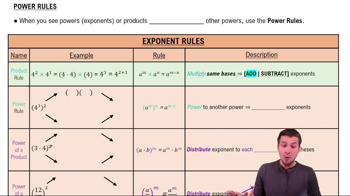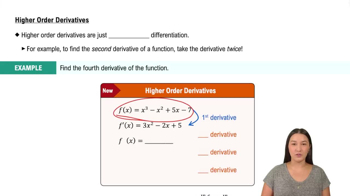Find the third derivative of the given function.
Table of contents
- 0. Functions7h 54m
- Introduction to Functions16m
- Piecewise Functions10m
- Properties of Functions9m
- Common Functions1h 8m
- Transformations5m
- Combining Functions27m
- Exponent rules32m
- Exponential Functions28m
- Logarithmic Functions24m
- Properties of Logarithms36m
- Exponential & Logarithmic Equations35m
- Introduction to Trigonometric Functions38m
- Graphs of Trigonometric Functions44m
- Trigonometric Identities47m
- Inverse Trigonometric Functions48m
- 1. Limits and Continuity2h 2m
- 2. Intro to Derivatives1h 33m
- 3. Techniques of Differentiation3h 18m
- 4. Applications of Derivatives2h 38m
- 5. Graphical Applications of Derivatives6h 2m
- 6. Derivatives of Inverse, Exponential, & Logarithmic Functions2h 37m
- 7. Antiderivatives & Indefinite Integrals1h 26m
- 8. Definite Integrals4h 44m
- 9. Graphical Applications of Integrals2h 27m
- 10. Physics Applications of Integrals 3h 16m
- 11. Integrals of Inverse, Exponential, & Logarithmic Functions2h 31m
- 12. Techniques of Integration7h 41m
- 13. Intro to Differential Equations2h 55m
- 14. Sequences & Series5h 36m
- 15. Power Series2h 19m
- 16. Parametric Equations & Polar Coordinates7h 58m
3. Techniques of Differentiation
Higher Order Derivatives
Problem 3.15
Textbook Question
If f(t)=t¹⁰, find f′(t), f′′(t), and f′′′(t).
 Verified step by step guidance
Verified step by step guidance1
Step 1: To find the first derivative, f'(t), apply the power rule of differentiation. The power rule states that if f(t) = t^n, then f'(t) = n * t^(n-1). For f(t) = t^10, n = 10.
Step 2: Calculate f'(t) using the power rule: f'(t) = 10 * t^(10-1) = 10 * t^9.
Step 3: To find the second derivative, f''(t), differentiate f'(t) = 10 * t^9 again using the power rule. Here, n = 9.
Step 4: Calculate f''(t) using the power rule: f''(t) = 9 * 10 * t^(9-1) = 90 * t^8.
Step 5: To find the third derivative, f'''(t), differentiate f''(t) = 90 * t^8 once more using the power rule. Here, n = 8.
 Verified video answer for a similar problem:
Verified video answer for a similar problem:This video solution was recommended by our tutors as helpful for the problem above
Video duration:
3mPlay a video:
Was this helpful?
Key Concepts
Here are the essential concepts you must grasp in order to answer the question correctly.
Differentiation
Differentiation is the process of finding the derivative of a function, which represents the rate of change of the function with respect to its variable. In this case, we will apply the power rule, which states that the derivative of t^n is n*t^(n-1), to find the first, second, and third derivatives of the function f(t) = t¹⁰.
Recommended video:

Finding Differentials
Power Rule
The power rule is a fundamental rule in calculus used to differentiate functions of the form f(t) = t^n, where n is a real number. According to this rule, the derivative f'(t) is calculated as n*t^(n-1). This rule simplifies the differentiation process, making it easier to compute higher-order derivatives.
Recommended video:
Guided course

Power Rules
Higher-Order Derivatives
Higher-order derivatives refer to the derivatives of a function taken multiple times. The first derivative f'(t) gives the rate of change, the second derivative f''(t) provides information about the curvature or concavity of the function, and the third derivative f'''(t) can indicate the rate of change of the curvature. Understanding these derivatives is essential for analyzing the behavior of functions.
Recommended video:

Higher Order Derivatives

 2:42m
2:42mWatch next
Master Higher Order Derivatives with a bite sized video explanation from Patrick
Start learningRelated Videos
Related Practice
Multiple Choice
